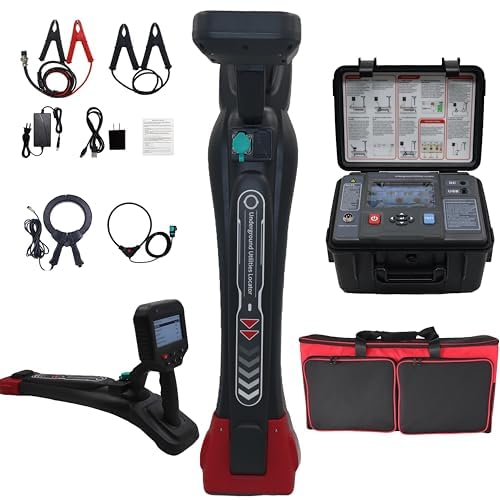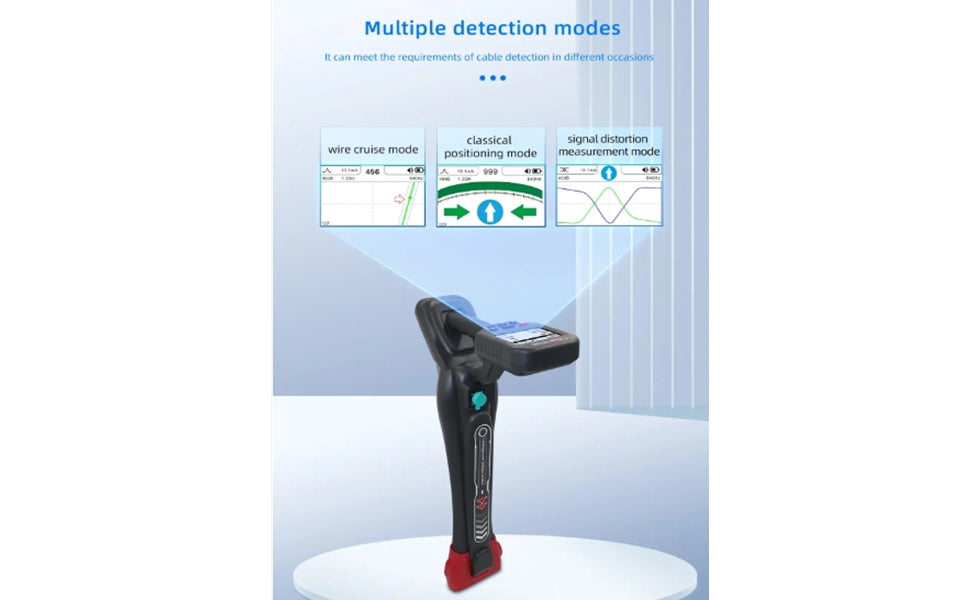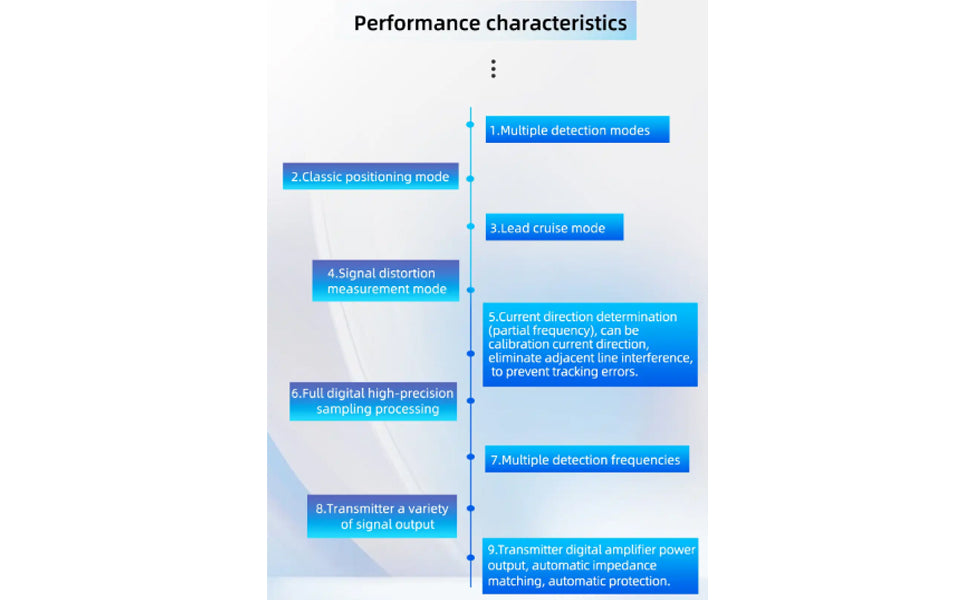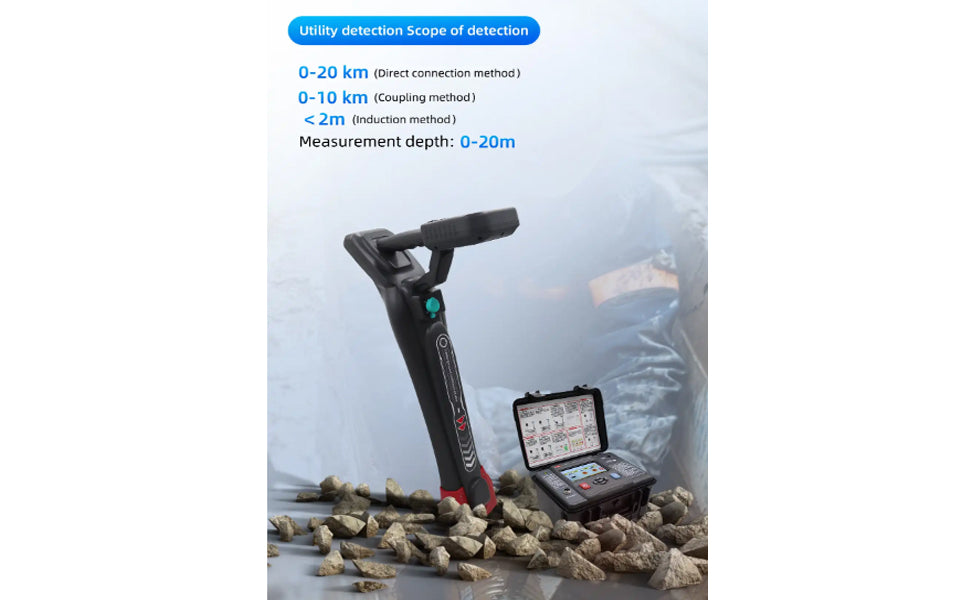
VTSYIQI
Underground Utility Locator Pipe Cable Locator Detection with 20m Depth Transmitter Receiver Built-in Receiver Coil Accuracy ± 5% to -10% for Cable Tracking Direction Depth Current IEC61010
- 常规价格
- $3,589.00

Underground Utility Locator Pipe Cable Locator Detection with 20m Depth Transmitter Receiver Built-in Receiver Coil Accuracy ± 5% to -10% for Cable Tracking Direction Depth Current IEC61010
Feature:
Intelligent pipeline detector, also known as underground utility cable locator, cable path instrument, is a path detection instrument with strong comprehensive performance. It has pipeline path detection, cable identification, fault search and other functions. The instrument is composed of transmitter, transmitting current clamp, receiver, receiving flexible current clamp, connecting test line, A-fault locator frame (optional), etc.Intelligent pipeline detector can be used for path detection, pipeline survey and depth measurement of metal pipelines and underground cables under trenchless excavation.
Cable identification is designed for power cable engineers and cable workers to solve the technical problems of cable identification. Can be used to identify live cables and blackout cables. The user accurately identifies one of the target cables from multiple cables through the instrument to avoid missawing non target cables. When cable identification, 20 cables can be pre-rated at the transmitting end, and then received and identified at the far end, which greatly saves the calibration operation time of engineering personnel and improves the work efficiency.
Signal transmitter: used for pipeline path detection and cable identification.The device can add identification signals to the target cable through direct connection output, caliper coupling, induction method, and so on. There are 13 different pulse signals of 250Hz, 577Hz, 640Hz, 1.28kHz, 2.56kHz, 3.20kHz, 4.09kHz, 8.19kHz, 10.2kHz, 33 kHz, 66 kHz, 82 kHz, and 197 kHz.The maximum signal output power is 15W, and 6 levels are adjustable, adapting to different application environments, making pipeline detection and cable identification more accurate and reliable.Instrument built-in large function rate can be charged with lithium battery, automatic impedance matching, automatic protection.
Receiver:For pipeline path detection and cable identification. Built-in shielding 3D antennas can effectively identify 13 different pulse-coded current signals of 250Hz, 577Hz, 640Hz, 1280Hz, 2.56kHz, 3.20kHz, 4.09kHz, 8.19kHz, 10.2kHz, 33 kHz, 66 kHz, 82 kHz and 197 kHz generated by the transmitter, and 50Hz and 60Hz power frequency signals and center frequencies of 33 kHz and 82 kHz.Use a 4.3-inch capacitive touch LCD screen, real-time dynamic display of 360 comprehensive pipeline path indication, depth, current and relative pipeline position.
Flexible current clamp:For the cable identification. The current clamp is a Roche coil, with excellent transient tracking ability, and can quickly identify the pulse width frequency signals generated by the transmitter. It is suitable for thick cables or irregularly shaped conductors.The inner diameter of the jaw is about 200mm, can clamp Φ200mm below the cable, do not need to disconnect the measured line, non-contact measurement, safe and fast.
Special note: When power outage cable identification: no access to the live cable. Live cable identification is only applicable to three-core armored cable. When identifying, the transmitting clamp and the receiving clamp should not be mixed, and the direction of the input signal should be consistent.
Characteristics:1.Multiple detection modes: classical positioning mode, wire cruise mode, signal distortion measurement mode;2.Classic positioning mode: compass, direction and signal amplitude display, visually display the left and right direction of the pipeline。3.Lead cruise mode: 360 omnidirectional pipeline path indication, continuous display of depth, current, and pipeline relative position. The interface is simple and intuitive, and it can be operated without experience4.Signal distortion measurement mode: the peak and trough wave form should be displayed at the same time. In the field without distortion, the peak and valley value position should be consistent
Introduction:
1.Multiple detection modes: classical positioning mode, wire cruise mode, signal distortion measurement mode;
2.Classic positioning mode: compass, direction and signal amplitude display, visually display the left and right direction of the pipeline
3.Lead cruise mode: 360 omnidirectional pipeline path indication, continuous display of depth, current, and pipeline relative position. The interface is simple and intuitive, and it can be operated without experience
4.Signal distortion measurement mode: the peak and trough wave form should be displayed at the same time. In the field without distortion, the peak and valley value position should be consistent, and the field shape should be symmetrical relative to the centrol line.
5.Current direction determination (partial frequency), can be calibration current direction, eliminate adjacent line interference, to prevent tracking errors.
6.Full digital high-precision sampling processing: stable and reliable, ultra-high sensitivity, extremely narrow reception frequency band, strong anti-interference ability, can fully inhibit the power frequency and harmonic interference of adjacent running cables and pipelines.
7.Multiple detection frequencies: 13 active detection frequencies and 2 passive detection frequencies.
8.Transmitter a variety of signal output: direct output, caliper coupling, induction method.
9.Transmitter digital amplifier power output, automatic impedance matching, automatic protection.
Receiver specifications:
Function:Utility detector(cable position tracking, direction display, depth measurement, current measurement), cable identification, A-frame fault detection (optional function)
Power:8.4V large capacity rechargeable lithium battery
Input mode:Built-in receiving coil, flexible caliper, A-frame (optional function)
Receive frequency:Active detection frequency:250Hz、577Hz、640Hz、1.28kHz、2.56kHz、3.20kHz、4.09kHz、8.19kHz、10.2kHz、33kHz、66kHz、82kHz、197kHz
Power frequency passive detection frequency:50Hz、60Hz
RF passive detection frequency band: the central frequency is divided into33kHz、66kHz、82kHz、197kHz
Utility detector modes:Wide peak method, narrow peak method, sound valley method
Utility detector display modes:Classic positioning mode, wire cruise mode, signal distortion measurement mode
Utility detection Scope of detection:
Direct connection method: generally can reach the cable length of 0~20 kilometers, mainly determined by the grounding resistance, cable resistance and cable buried depth Coupling method: generally can reach the length of the cable 0~10 kilometers, mainly determined by the grounding resistance, cable resistance and cable buried depth Induction method: suitable for cables with buried depth less than 2m
Depth and current:Display the cable depth and current value in real time
Measurement depth:0-20m
Deep precision:Flat position precision accuracy: Central axis position of the target cable or pipeline:± 5% (buried depth in 0-3m) -10% (buried depth in 3m-20m)
Positive and wrong prompt: Excluding the interference of adjacent cables, in the measurement of adjacent cables, the measurement of the adjacent cables can be distinguished according to the different signal strength and the measured current phase of the adjacent cables. In the process of tracking the cables, the phase dial and pointer can be observed to distinguish the measured cables and the adjacent cables
Sound instructions:FM tone with signal intensity
Capacity of resisting disturbance:Very narrow receiving frequency band and unique digital processing method can fully suppress the power frequency and harmonic interference of adjacent operating cables and pipelines
Interference distance:
When using the coupling method and the induction method, the transmitter will produce interference in close distance. The distance of interference is related to the transmitting power and frequency. The greater the power, the higher the frequency, the stronger the interference.The minimum distance of the receiver free from the transmitter interference often needs to be determined by test:
Utility detection: 5m away, 20m away as no interference
Cable identification: the coupling method beyond 2~5m can be confirmed as no interference
Cable identification:
Identification mode: flexible caliper intelligent identification;
Number of calibrable cables: 1~20;
Calibration value: the current percentage of the received signal and the transmitted signal between 75% and 135% of the calibration value is one of the conditions for successful identification;
Directionality: the transmitter clamp, receiver clamp must be in the same direction as the loading signal, which is one of the conditions for successful identification
Direct connection method: can identify the signal with a circuit resistance of 0 Ω ~ 8 kΩ (generally, the length of the cable can reach 0~20 km, mainly determined by the grounding resistance and cable resistance)
Coupling method: can identify the signal with circuit resistance of 0 Ω ~ 1 kΩ; (generally the cable length is 0~6 km, mainly determined by the grounding resistance and cable resistance)
Display:4.3 LCD color screen LCD (highlight screen), visible in the sun
Touchscreen:Yes
Size:350mm(length)×155mm(width)×700mm(high)
Weight:Around 2kg
Connection interface:Type-C USB Interface, air socket
Coil inner diameter:φ200mm(A larger caliber can be customized as needed)
Working temperature and humidity:-10℃~40℃;below 80%Rh
Store temperature and humidity:-10℃~50℃;≤95%RH, No knot dew
Withstand voltage:AC2000V/rms(Before the front and rear ends of the shell)
Suitable for safety regulations:IEC61010-1 CAT Ⅲ 600V,IEC61010-031,IEC61326,Pollution grade 2
Receiver specifications:
What level of performance can I expect from 4K Color Drive?
Video heading
Give customers details about the video




















